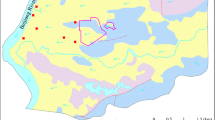Abstract
As the demand for energy grows steadily and fossil fuels are depleted gradually, nuclear power will continue to play an important role in meeting energy needs in the future. Uranium, as the fuel for nuclear power generation, has experienced the increase in production in recent years. Acid in situ leach uranium mining is an effective and popular technique to extract uranium without exposure of workers to radioactive ore deposits. Despite this advantage, this technique causes extremely high concentrations of contaminants in confined aquifers after mining is completed. These contaminants will undergo natural attenuation while migrating downgradient with regional groundwater. Mounting concerns have been raised regarding widespread groundwater contamination due to concentrations of contaminants and lack of published studies for comparison. In this study, the fate of various contaminants was examined to infer the extent of natural attenuation in a confined aquifer in northwest China. Results indicate the efficiency of natural attenuation in the confined aquifer. In addition, the contaminant plume migrated much slower than regional groundwater. The dual-domain theory has been invoked to aid in the interpretation of the decoupling of the plume migration with the regional groundwater flow. This study also implies that widespread contamination in confined aquifers is more likely to be caused by external factors (e.g., mechanical failure, human errors) than post-mining spreading of contaminants. To be always safe, strict monitoring schemes must still be established and operated.





Similar content being viewed by others
References
Bain JG, Mayer KU, Blowes DW, Frind EO, Molson JWH, Kahnt R, Jenk U (2001) Modeling the closure-related geochemical evolution of groundwater at a former uranium mine. J Contam Hydrol 52:109–135
Bekins BA, Rittmann BE, MacDonald JA (2001) Natural attenuation strategy for groundwater cleanup focuses on demonstrating cause and effect. EOS Trans AGU 82:57–58
Borch T, Roche N, Johnson TE (2012) Determination of contaminant levels and remediation efficacy in groundwater at a former in situ recovery uranium mine. J Environ Monit 14:1814–1823
Eychaner JH (1991) The Globe, Arizona Research Site—contaminants related to copper mining in a hydrologically integrated environment. In: Mallard GE, Aroonson DA (ed) US Geological Survey Water Resources Investigation Report 91-4043, pp 481–485. http://pubs.usgs.gov/wri/1991/4034/report.pdf. Accessed 18 Aug 2013
Haggerty R, Fleming SW, Meigs LC, McKenna SA (2001) Tracer tests in a fractured dolomite: 2. Analysis of mass transfer in single-well injection-withdrawal tests. Water Resour Res 37:1129–1142
IAEA (2011) International status and prospects of nuclear power 2010 edition. International Atomic Energy Agency Report. http://www.iaea.org/Publications/Booklets/NuclearPower/np10.pdf. Accessed 1 Oct 2013
Kim D, Song W, Lu JC (2011) Interdisciplinary investigation of contaminants fate and transport at a former UST site (10-year case study). Environ Earth Sci 64:277–291
Lasagna M, De Luca D, Debernardi L, Clemente P (2013) Effect of the dilution process on the attenuation of contaminants in aquifers. Environ Earth Sci 70:2767–2784
Liu G, Zheng C, Gorelick SM (2007) Evaluation of the applicability of the dual-domain mass transfer model in porous media containing connected high-conductivity channels. Water Resour Res 43:W12407. doi:10.1029/2007WR005965
MOHPRC (2006) Ministry of Health of the People’s Republic of China Standards for Drinking Water Quality: GB 5749—2006. http://www.nhfpc.gov.cn/cmsresources/zwgkzt/wsbz/new/20070628143525.pdf. Accessed 10 Apr 2013
Mudd GM (1998) An environmental critique of in situ leach mining: the case against uranium solution mining. Vitoria University of Technology Research Report. http://www.powertechexposed.com/An_Environmental_Critique_of_ISL.pdf. Accessed 10 Jul 2013
Mudd GM (2001a) Critical review of acid in situ leach uranium mining: 1. USA and Australia. Environ Geol 41:390–403
Mudd GM (2001b) Critical review of acid in situ leach uranium mining: 2. Soviet Block and Asia. Environ Geol 41:404–416
Robertson WD, Roy JW, Brown SJ, Van Stempvoort DR, Bickerton G (2014) Natural attenuation of perchlorate in denitrified groundwater. Ground Water 52:63–70
Singleton MJ, Esser BK, Moran JE, Hudson GB, McNab WW, Harter T (2007) Saturated zone denitrification: potential for natural attenuation of nitrate contamination in shallow groundwater under dairy operations. Environ Sci Technol 41:759–765
Stollenwerk KM (1994) Geochemical interactions between constituents in acidic groundwater and alluvium in an aquifer near Globe, Arizona. Appl Geochem 9:353–369
Taylor G, Farrington V, Woods P, Ring R, Molloy R (2004) Review of environmental impacts of the acid in situ leach uranium mining process. CSIRO Land and Water Client Report. http://epa.sa.gov.au/files/4771310_isl_review.pdf. Accessed 05 May 2011
WHO (2011) World Health Organization guidelines for drinking-water quality, fourth edition. http://apps.who.int/iris/bitstream/10665/44584/1/9789241548151_eng.pdf.. Accessed 12 Apr 2013
Zhu C, Anderson GM, Burden DS (2001a) Natural attenuation reactions at a uranium mill tailings site, western USA. Ground Water 40:5–13
Zhu C, Hu FQ, Burden DS (2001b) Multi-component reactive transport modeling of natural attenuation of an acid groundwater plume at a uranium mill tailings site. J Contam Hydrol 52:85–108
Acknowledgments
This research was supported by the National Natural Science Foundation of China (Grant No. 41202182), the Strategic Priority Research Program of the Chinese Academy of Sciences (Grant No. XDB10030601) and State Key Laboratory for Coal Resources and Safe Mining, China University of Mining and Technology (Grant No. SKLCRSM12KFA02). We are grateful to the anonymous reviewers for their constructive comments and suggestions that greatly improved the manuscript. The authors would like to thank James McCallum for improving the English quality of the manuscript. We also appreciate that Jinyuan Uranium Company provided the unpublished field investigation report (in Chinese), which is available upon request through the corresponding author.
Author information
Authors and Affiliations
Corresponding author
Electronic supplementary material
Below is the link to the electronic supplementary material.
Rights and permissions
About this article
Cite this article
Dong, Y., Xie, Y., Li, G. et al. Efficient natural attenuation of acidic contaminants in a confined aquifer. Environ Earth Sci 75, 595 (2016). https://doi.org/10.1007/s12665-016-5389-8
Received:
Accepted:
Published:
DOI: https://doi.org/10.1007/s12665-016-5389-8




